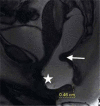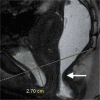Magnetic resonance defecography findings of dyssynergic defecation
- PMID: 35505854
- PMCID: PMC9047849
- DOI: 10.5114/pjr.2022.114866
Magnetic resonance defecography findings of dyssynergic defecation
Abstract
Dyssynergic defecation (DD) is defined as paradoxical contraction or inadequate relaxation of the pelvic floor muscles during defecation, which causes functional constipation. Along with the anal manometry and balloon expulsion tests, magnetic resonance (MR) defecography is widely used to diagnose or rule out pelvic dyssynergia. Besides the functional abnormality, structural pathologies like rectocele, rectal intussusception, or rectal prolapse accompanying DD can also be well demonstrated by MR defecography. This examination can be an uncomfortable experience for the patient, so the imaging method and the importance of patient cooperation must be explained in detail. The defecatory phase of the examination is indispensable for evaluation, and inadequate effort should be ruled out before diagnosing DD. MR defecography provides important data for the diagnosis of DD, but optimal imaging criteria should be applied. Further tests can be suggested if patient co-operation is not sufficient or MR defecography findings are irrelevant.
Keywords: MR defecography; anismus; dyssynergic defecation; pelvic floor.
© Pol J Radiol 2022.
Conflict of interest statement
The authors report no conflict of interest.
Figures





Similar articles
-
MR Defecography in Assessing Functional Defecation Disorder: Diagnostic Value of the Defecation Phase in Detection of Dyssynergic Defecation and Pelvic Floor Prolapse in Females.Digestion. 2019;100(2):109-116. doi: 10.1159/000494249. Epub 2019 Jan 29. Digestion. 2019. PMID: 30695788
-
Balloon expulsion testing for the diagnosis of dyssynergic defecation in women with chronic constipation.Int Urogynecol J. 2015 Sep;26(9):1385-90. doi: 10.1007/s00192-015-2722-9. Epub 2015 Jun 18. Int Urogynecol J. 2015. PMID: 26085464
-
Integrating anorectal manometry, balloon expulsion, and defecography: insights into diagnosing pelvic floor dysfunction.Am J Physiol Gastrointest Liver Physiol. 2025 Aug 1;329(2):G270-G275. doi: 10.1152/ajpgi.00100.2025. Epub 2025 Jun 26. Am J Physiol Gastrointest Liver Physiol. 2025. PMID: 40569575
-
Imaging and clinical assessment of functional defecatory disorders with emphasis on defecography.Abdom Radiol (NY). 2021 Apr;46(4):1323-1333. doi: 10.1007/s00261-019-02142-9. Abdom Radiol (NY). 2021. PMID: 31332501 Review.
-
Consensus statement AIGO/SICCR: diagnosis and treatment of chronic constipation and obstructed defecation (part I: diagnosis).World J Gastroenterol. 2012 Apr 14;18(14):1555-64. doi: 10.3748/wjg.v18.i14.1555. World J Gastroenterol. 2012. PMID: 22529683 Free PMC article.
Cited by
-
Role of magnetic resonance defecography in the assessment of obstructed defecation syndrome.World J Radiol. 2025 Jun 28;17(6):107205. doi: 10.4329/wjr.v17.i6.107205. World J Radiol. 2025. PMID: 40606048 Free PMC article. Review.
-
Pelvic floor dysfunction in patients with gestational diabetes mellitus.World J Diabetes. 2025 Feb 15;16(2):99823. doi: 10.4239/wjd.v16.i2.99823. World J Diabetes. 2025. PMID: 39959261 Free PMC article.
References
-
- Black CJ, Ford AC. Chronic idiopathic constipation in adults: epidemiology, pathophysiology, diagnosis and clinical management. Med J Aust 2018; 209: 86-91. - PubMed
-
- Kanmaniraja D, Arif-Tiwari H, Palmer SL, et al. . MR defecography review. Abdom Radiol (NY) 2021; 46: 1334-1350. - PubMed
-
- Lalwani N, El Sayed RF, Kamath A, Lewis S, Arif H, Chernyak V. Imaging and clinical assessment of functional defecatory disorders with emphasis on defecography. Abdom Radiol (NY) 2021; 46: 1323-1333. - PubMed
-
- Bharucha AE, Wald A, Enck P, Rao S. Functional anorectal disorders. Gastroenterology 2006; 130: 1510-1518. - PubMed
Publication types
LinkOut - more resources
Full Text Sources
